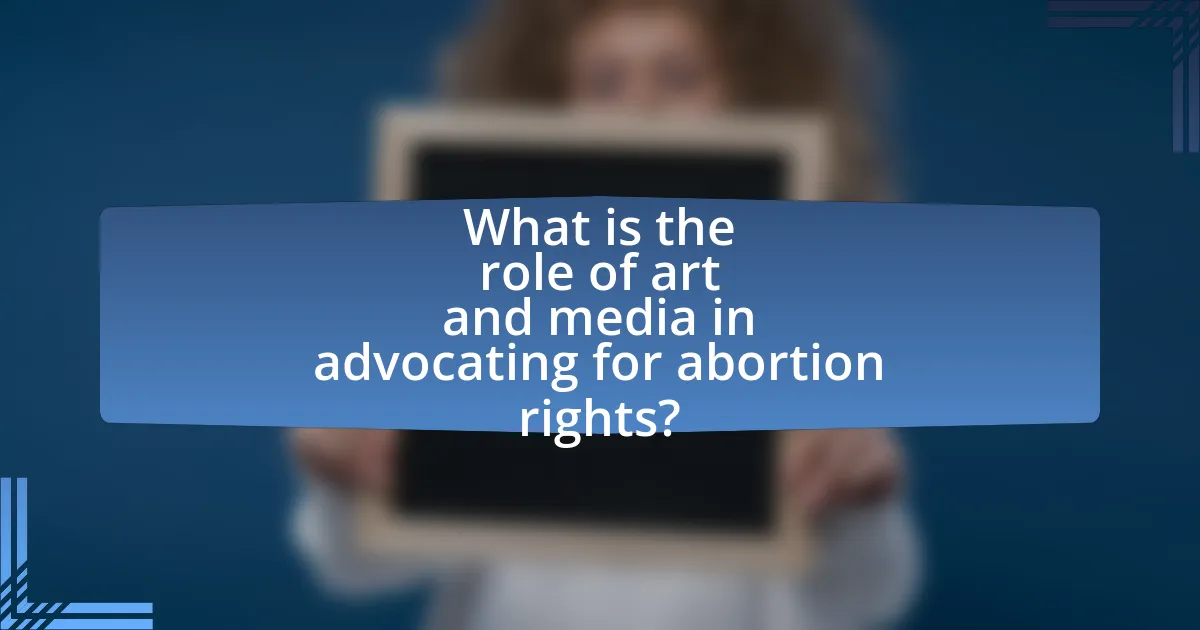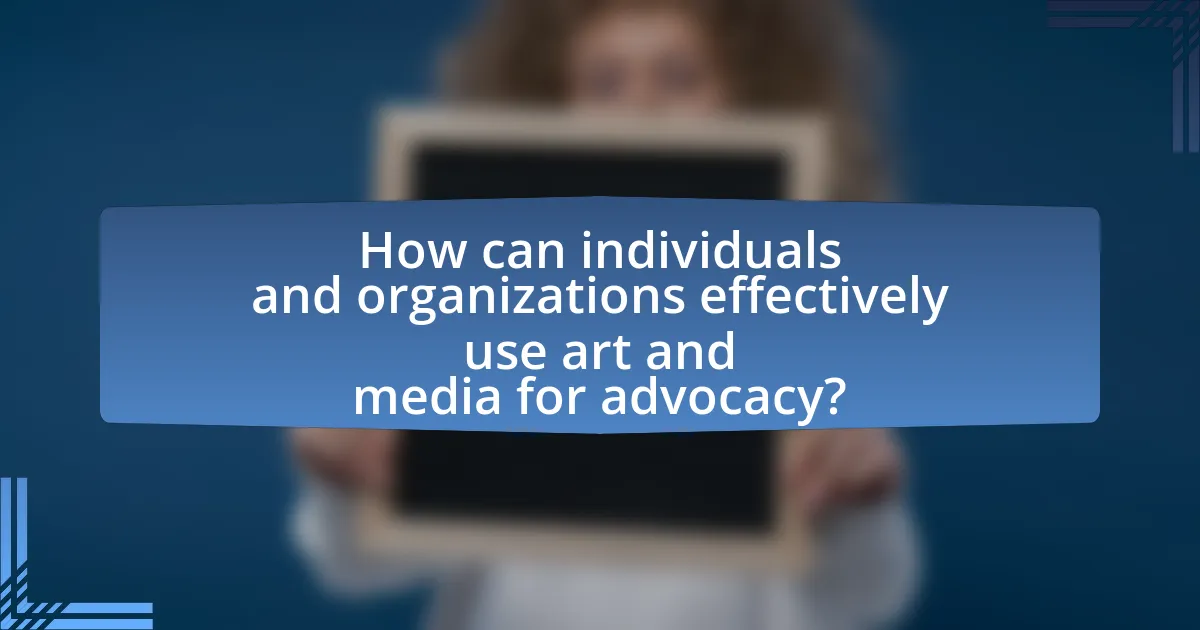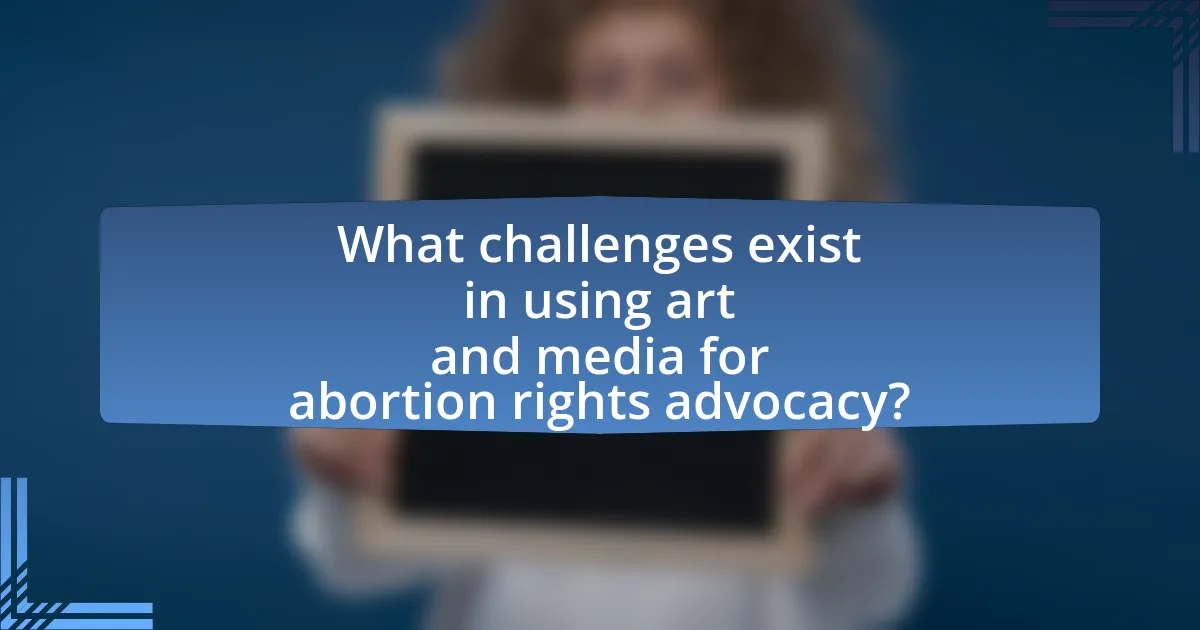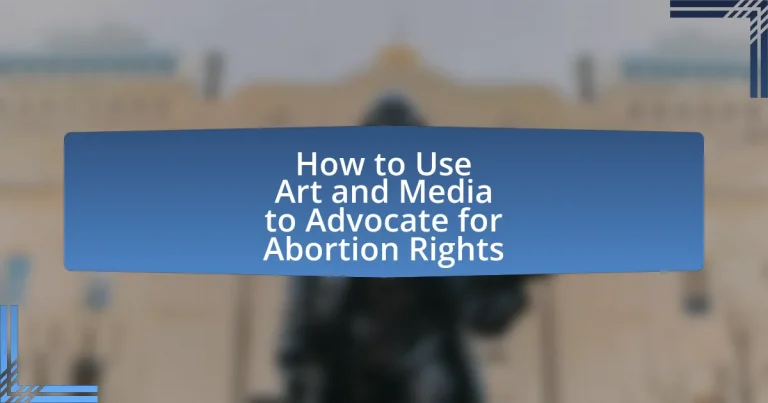The article focuses on the role of art and media in advocating for abortion rights, emphasizing their significance in shaping public perception and fostering dialogue. It explores how various forms of artistic expression, including visual art, literature, and social media campaigns, can challenge stigmas, highlight personal stories, and mobilize communities. Key strategies for effective advocacy are discussed, including the use of targeted messaging, diverse representation, and collaboration with activists. The article also addresses the challenges and ethical considerations involved in using art and media for this purpose, providing practical tips for individuals and organizations to engage effectively in the fight for abortion rights.

What is the role of art and media in advocating for abortion rights?
Art and media play a crucial role in advocating for abortion rights by shaping public perception and fostering dialogue around the issue. Through various forms of expression, such as visual art, film, literature, and social media campaigns, artists and creators can highlight personal stories, challenge stigmas, and mobilize communities. For instance, the “Shout Your Abortion” campaign utilizes social media to encourage individuals to share their abortion experiences, thereby normalizing the conversation and reducing shame. Research indicates that narratives presented through art can significantly influence attitudes and beliefs, making them powerful tools for advocacy.
How can art influence public perception of abortion rights?
Art can significantly influence public perception of abortion rights by shaping narratives and evoking emotional responses. Through visual art, literature, and performance, artists can challenge societal norms and highlight personal stories related to abortion, fostering empathy and understanding. For instance, the 2019 art exhibit “Abortion is Normal” showcased diverse perspectives on abortion, aiming to destigmatize the experience and promote dialogue. This approach can lead to increased awareness and support for abortion rights, as evidenced by studies showing that personal stories in art can shift public attitudes more effectively than statistics alone.
What types of art are most effective in conveying messages about abortion rights?
Visual art, particularly graphic design and illustration, is most effective in conveying messages about abortion rights. These forms of art can quickly communicate complex ideas and emotions through powerful imagery and symbolism, making them accessible to a broad audience. For instance, campaigns like “Shout Your Abortion” utilize striking visuals to normalize conversations around abortion, effectively challenging stigma and promoting advocacy. Additionally, performance art, such as theater and spoken word, engages audiences emotionally and can create a visceral connection to the issues surrounding abortion rights, as seen in productions like “The Vagina Monologues,” which address women’s experiences and rights. These art forms not only raise awareness but also inspire action and dialogue, proving their effectiveness in the advocacy landscape.
How does visual storytelling impact the abortion rights discourse?
Visual storytelling significantly influences the abortion rights discourse by shaping public perception and emotional engagement. Through images, videos, and narratives, visual storytelling humanizes the experiences of individuals affected by abortion, fostering empathy and understanding. For instance, campaigns like “Shout Your Abortion” utilize personal stories and visuals to challenge stigma and promote open dialogue, effectively altering societal attitudes. Research indicates that emotional appeals in visual media can lead to increased support for abortion rights, as evidenced by studies showing that viewers are more likely to advocate for policy changes after engaging with emotionally resonant content.
What media platforms are best for advocating abortion rights?
Social media platforms such as Twitter, Instagram, and Facebook are best for advocating abortion rights. These platforms enable rapid dissemination of information, facilitate community engagement, and allow for the sharing of personal stories, which can humanize the issue. For instance, a study by the Pew Research Center found that 69% of adults in the U.S. use Facebook, making it a powerful tool for mobilizing support and raising awareness about abortion rights. Additionally, Twitter’s character limit encourages concise messaging, which can effectively capture attention and spark conversations around the topic.
How do social media campaigns shape the conversation around abortion rights?
Social media campaigns significantly shape the conversation around abortion rights by amplifying diverse voices and mobilizing public opinion. These campaigns utilize platforms like Twitter, Instagram, and Facebook to disseminate information, share personal stories, and organize grassroots movements, thereby increasing visibility and engagement on the topic. For instance, the #ShoutYourAbortion campaign encourages individuals to openly discuss their experiences with abortion, challenging stigma and fostering a supportive community. Research indicates that social media can influence public attitudes; a study published in the Journal of Communication found that exposure to pro-abortion rights content on social media correlates with increased support for abortion access among users.
What role do traditional media outlets play in abortion rights advocacy?
Traditional media outlets play a crucial role in abortion rights advocacy by shaping public discourse and influencing perceptions about reproductive rights. They provide a platform for diverse voices, including activists, healthcare professionals, and individuals sharing personal experiences, which helps to humanize the issue and foster empathy. For instance, coverage of landmark legal cases, such as Roe v. Wade, has historically informed the public about the implications of abortion laws and mobilized support for reproductive rights. Additionally, traditional media can amplify advocacy campaigns, as seen in the extensive reporting on the Women’s March and other pro-choice demonstrations, which raises awareness and encourages civic engagement.
Why is it important to use art and media in the fight for abortion rights?
Using art and media in the fight for abortion rights is important because they serve as powerful tools for raising awareness and shaping public opinion. Art and media can humanize the issue by telling personal stories, which fosters empathy and understanding among diverse audiences. For instance, campaigns like “Shout Your Abortion” have effectively utilized social media and visual art to normalize conversations around abortion, leading to increased visibility and support for reproductive rights. Additionally, studies show that visual storytelling can significantly impact attitudes, making art and media essential in mobilizing communities and influencing policy change.
How does art humanize the issue of abortion?
Art humanizes the issue of abortion by portraying personal stories and emotional experiences that resonate with individuals on a deeper level. Through various mediums such as visual art, literature, and performance, artists can express the complexities of abortion, highlighting the diverse perspectives and feelings involved, including grief, empowerment, and choice. For instance, works like “The Abortion Diaries,” a collection of personal narratives, provide insight into the lived experiences of those who have undergone the procedure, fostering empathy and understanding. This emotional engagement encourages dialogue and reflection, making the topic more relatable and less abstract, ultimately contributing to a more nuanced public discourse surrounding abortion rights.
What historical examples demonstrate the effectiveness of art in social movements?
Art has historically played a crucial role in social movements, effectively raising awareness and mobilizing support. For instance, the Harlem Renaissance in the 1920s utilized literature, music, and visual arts to challenge racial discrimination and promote African American culture, significantly influencing civil rights activism. Additionally, the anti-war movement during the Vietnam War saw the use of protest songs, such as Bob Dylan’s “Blowin’ in the Wind,” which galvanized public sentiment against the war and highlighted the human cost of conflict. Furthermore, the AIDS activism of the 1980s, exemplified by the work of the group ACT UP, employed powerful visual art and slogans to demand government action and healthcare access, leading to significant policy changes. These examples illustrate how art not only reflects societal issues but also serves as a catalyst for change, effectively engaging communities and influencing public opinion.

How can individuals and organizations effectively use art and media for advocacy?
Individuals and organizations can effectively use art and media for advocacy by creating compelling narratives that resonate emotionally with their audience. For instance, visual art, such as paintings or installations, can evoke strong feelings and provoke thought about abortion rights, while documentaries and social media campaigns can disseminate factual information and personal stories that highlight the importance of these rights. Research shows that emotional engagement through storytelling can significantly increase public support for social issues, as evidenced by campaigns like the “Shout Your Abortion” movement, which successfully utilized personal narratives to challenge stigma and promote understanding. By leveraging various forms of media, advocates can reach diverse audiences, foster dialogue, and mobilize support for abortion rights effectively.
What strategies can be employed to create impactful art for abortion rights?
To create impactful art for abortion rights, artists can employ strategies such as using personal narratives, collaborating with activists, and engaging in public installations. Personal narratives allow artists to share individual experiences related to abortion, fostering empathy and understanding among audiences. Collaborating with activists ensures that the art aligns with current movements and messages, amplifying the voices of those directly affected by abortion policies. Public installations, such as murals or interactive exhibits, can provoke dialogue and raise awareness in community spaces, making the issue more visible. These strategies have been effective in various campaigns, as seen in the “Shout Your Abortion” movement, which encourages open discussions about abortion experiences, thereby normalizing the conversation and reducing stigma.
How can artists collaborate with activists to amplify their message?
Artists can collaborate with activists to amplify their message by creating impactful visual and performance art that conveys the urgency of the cause. For instance, artists can design posters, murals, or installations that highlight key issues surrounding abortion rights, thereby reaching a broader audience. Collaborative events, such as art exhibitions or performances, can serve as platforms for activists to share their messages, while artists can use their creative skills to enhance the emotional resonance of these messages. Historical examples include the “Art Against War” campaign, where artists used their work to protest against policies affecting reproductive rights, effectively mobilizing public support and awareness. This synergy between art and activism not only raises visibility but also fosters community engagement and dialogue around critical issues.
What are the best practices for creating inclusive and diverse representations in art related to abortion rights?
The best practices for creating inclusive and diverse representations in art related to abortion rights include actively engaging with a variety of voices and experiences, ensuring representation of marginalized communities, and utilizing intersectional perspectives. Engaging with diverse voices involves collaborating with individuals who have lived experiences related to abortion, including those from different racial, socioeconomic, and gender backgrounds. This approach fosters authenticity and relatability in the artwork.
Ensuring representation of marginalized communities is crucial, as studies show that art reflecting diverse experiences can challenge stereotypes and promote understanding. For instance, the National Endowment for the Arts highlights the importance of diversity in artistic expression to foster social change. Utilizing intersectional perspectives allows artists to address the complexities of abortion rights, considering factors such as race, class, and gender identity, which can lead to more nuanced and impactful representations.
In summary, these practices not only enhance the inclusivity of the artwork but also contribute to a broader dialogue about abortion rights, making the art more relevant and powerful in advocating for change.
How can media campaigns be structured to maximize outreach?
Media campaigns can be structured to maximize outreach by employing targeted messaging, utilizing diverse platforms, and engaging with the audience through interactive content. Targeted messaging ensures that the campaign resonates with specific demographics, increasing relevance and engagement; for instance, campaigns that address the concerns of young women may use social media platforms like Instagram and TikTok, where this demographic is most active. Utilizing diverse platforms, including traditional media, social media, and community events, broadens the reach and allows for different types of engagement, as evidenced by the success of campaigns that combine online and offline strategies. Engaging the audience through interactive content, such as polls, discussions, and user-generated content, fosters a sense of community and encourages sharing, which can significantly amplify the campaign’s visibility. Research indicates that campaigns incorporating these elements can achieve up to 50% higher engagement rates compared to those that do not.
What elements should be included in a successful media campaign for abortion rights?
A successful media campaign for abortion rights should include clear messaging, targeted audience engagement, diverse representation, and strategic partnerships. Clear messaging ensures that the campaign communicates its goals effectively, using straightforward language that resonates with the audience. Targeted audience engagement involves identifying specific demographics and tailoring content to their values and concerns, which can increase the campaign’s impact. Diverse representation is crucial to reflect the varied experiences and identities of individuals affected by abortion, fostering inclusivity and relatability. Strategic partnerships with organizations and influencers can amplify the campaign’s reach and credibility, leveraging their networks to spread the message more widely. These elements collectively enhance the effectiveness of a media campaign advocating for abortion rights.
How can storytelling be leveraged in media campaigns to engage audiences?
Storytelling can be leveraged in media campaigns to engage audiences by creating relatable narratives that evoke emotional responses and foster connections. Effective storytelling humanizes complex issues, such as abortion rights, by presenting personal experiences and diverse perspectives, which can resonate deeply with viewers. Research indicates that emotionally charged stories can increase empathy and understanding, leading to greater audience engagement. For instance, a study published in the journal “Health Communication” found that narratives about personal experiences with abortion significantly influenced attitudes and increased support for abortion rights among audiences. By utilizing storytelling, media campaigns can effectively communicate their messages and mobilize support for advocacy efforts.

What challenges exist in using art and media for abortion rights advocacy?
Using art and media for abortion rights advocacy faces several challenges, including censorship, misrepresentation, and audience polarization. Censorship occurs when platforms restrict content related to abortion, limiting the reach of advocacy messages. Misrepresentation arises when artistic interpretations do not accurately reflect the complexities of abortion, potentially alienating audiences or undermining the cause. Audience polarization is significant, as art and media can evoke strong emotional responses, leading to division rather than constructive dialogue. These challenges hinder effective communication and advocacy efforts in promoting abortion rights.
What are the potential risks of using art in abortion rights advocacy?
Using art in abortion rights advocacy carries potential risks such as misinterpretation, backlash from opposing groups, and oversimplification of complex issues. Misinterpretation can occur when artistic expressions are perceived differently than intended, leading to confusion or offense among audiences. Backlash from opposing groups may manifest in public protests or campaigns aimed at discrediting the artwork and its message, which can detract from the advocacy efforts. Additionally, art may oversimplify the nuanced and multifaceted nature of abortion rights, reducing a complex issue to a single narrative that fails to encompass diverse perspectives and experiences. These risks highlight the need for careful consideration and strategic planning when employing art as a tool for advocacy.
How can artists navigate backlash or censorship when advocating for abortion rights?
Artists can navigate backlash or censorship when advocating for abortion rights by employing strategic communication and community engagement. By framing their messages in ways that resonate with broader social issues, such as women’s rights and health care, artists can foster understanding and support. For instance, using inclusive language and relatable narratives can help mitigate negative reactions. Additionally, collaborating with established organizations that advocate for reproductive rights can provide artists with resources and a platform to amplify their voices while reducing the risk of censorship. Historical examples, such as the use of art in the Women’s March, demonstrate that collective action can effectively counter backlash and create a supportive environment for advocacy.
What ethical considerations should be taken into account when creating art about abortion?
When creating art about abortion, ethical considerations include respect for diverse perspectives, sensitivity to personal experiences, and the potential impact on public discourse. Artists must acknowledge that abortion is a deeply personal and often contentious issue, affecting individuals differently based on their cultural, religious, and socio-economic backgrounds. For instance, art that trivializes or demonizes the experience of those who have undergone abortions can perpetuate stigma and harm. Additionally, artists should consider the implications of their work on the broader societal conversation about reproductive rights, ensuring that their message contributes constructively rather than exacerbating divisions. Ethical art about abortion should aim to foster understanding and empathy, reflecting the complexity of the issue while advocating for the rights and autonomy of individuals.
How can advocates overcome barriers to effective media representation?
Advocates can overcome barriers to effective media representation by actively engaging with diverse media platforms and fostering partnerships with journalists and content creators. By building relationships with media professionals, advocates can ensure accurate and nuanced portrayals of abortion rights issues. Research indicates that representation in media significantly influences public perception; for instance, a study by the Guttmacher Institute found that positive media coverage can lead to increased public support for reproductive rights. Additionally, utilizing social media campaigns allows advocates to directly reach and mobilize audiences, bypassing traditional media gatekeepers. This strategic approach not only amplifies marginalized voices but also challenges prevailing narratives, ultimately leading to more comprehensive media representation of abortion rights.
What strategies can be used to counter misinformation in media portrayals of abortion rights?
To counter misinformation in media portrayals of abortion rights, employing fact-checking initiatives is essential. Fact-checking organizations, such as PolitiFact and FactCheck.org, analyze claims made in media and provide evidence-based corrections, helping to clarify misconceptions. Additionally, promoting media literacy programs equips the public with skills to critically evaluate sources and discern factual information from misinformation. Research indicates that individuals exposed to media literacy training are better at identifying biased or misleading content. Engaging in proactive communication strategies, such as social media campaigns that share accurate information and personal stories, can also effectively counteract false narratives. These strategies collectively enhance public understanding and support for abortion rights by ensuring that accurate information prevails in media discourse.
How can advocates ensure that marginalized voices are represented in their media efforts?
Advocates can ensure that marginalized voices are represented in their media efforts by actively engaging with those communities and incorporating their narratives into the content. This can be achieved through collaboration with local organizations that serve marginalized groups, conducting interviews, and amplifying the stories of individuals directly affected by abortion rights issues. Research shows that representation in media can significantly influence public perception and policy; for instance, a study by the American Psychological Association found that diverse representation leads to greater empathy and understanding among audiences. By prioritizing authentic voices and experiences, advocates can create more impactful and inclusive media campaigns that resonate with a broader audience.
What are some practical tips for using art and media to advocate for abortion rights?
Utilizing art and media effectively to advocate for abortion rights involves creating impactful visual and narrative content that resonates with audiences. Artists and advocates can produce compelling artwork, such as paintings, murals, or digital graphics, that convey messages about reproductive rights, highlighting personal stories and statistics to foster empathy and understanding. Engaging in social media campaigns can amplify these messages, using hashtags and shareable content to reach wider audiences; for instance, the #ShoutYourAbortion campaign has successfully encouraged individuals to share their experiences, normalizing discussions around abortion. Collaborating with filmmakers to create documentaries or short films can also provide a platform for personal narratives, showcasing the real-life implications of abortion access. Furthermore, organizing community events, such as art shows or performances, can create spaces for dialogue and mobilization, drawing attention to the cause while fostering community support. These strategies leverage the emotional power of art and media to advocate for abortion rights effectively.
How can individuals get involved in local art initiatives supporting abortion rights?
Individuals can get involved in local art initiatives supporting abortion rights by participating in community art projects, attending workshops, and collaborating with local artists and organizations focused on reproductive rights. Many cities host events such as art shows, mural projects, and fundraisers that directly support abortion access and awareness. For example, organizations like the National Network of Abortion Funds often partner with artists to create impactful visual campaigns. Engaging in these initiatives not only raises awareness but also fosters community solidarity around reproductive rights.
What resources are available for creating effective media content on abortion rights?
Resources for creating effective media content on abortion rights include organizations like the Guttmacher Institute, which provides research and data on reproductive health, and Planned Parenthood, which offers educational materials and advocacy tools. Additionally, the Center for Reproductive Rights supplies legal resources and case studies that can inform media narratives. These organizations publish reports, infographics, and toolkits that can enhance the quality and impact of media content focused on abortion rights. For instance, the Guttmacher Institute’s research highlights the importance of access to abortion services and the implications of restrictive laws, providing a factual basis for media discussions.


